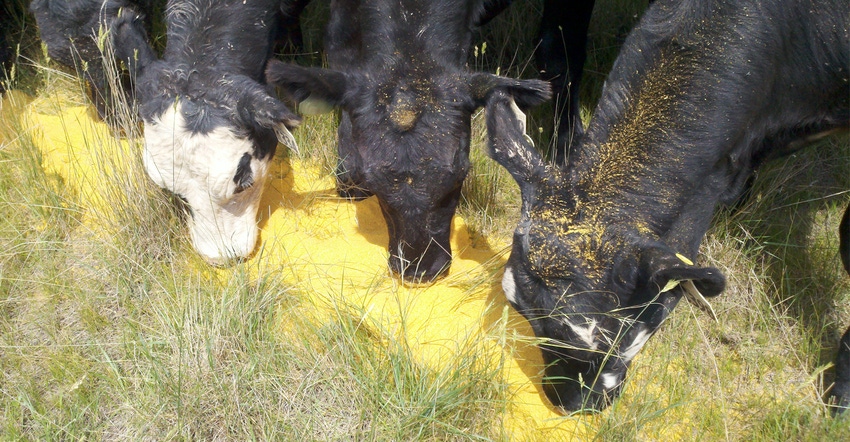
Even before the COVID-19 pandemic, there was a shortage of distillers grains. And while recent shortages may not necessarily be directly related to the pandemic, lower crude oil prices have played a role in lower ethanol production across the U.S. As a result, some beef producers may be facing shortages of distillers grains and seeking possible substitutes for beef cattle diets.
"We're really encouraging people to visit with their nutritionist or Extension specialist to get some help defining their goals and making up a new ration with a substituted commodity," says Karla Wilke, Nebraska Extension cow-calf and stocker management specialist. "The problem is DDGs are not only a great rumen undegradable protein [about 60% RUP] source and not only do they recycle nitrogen back to the rumen, it's also a good energy source. It's 108% TDN [total digestible nutrients] on a forage-based diet."
Rumen undegradable protein goes through the rumen without being digested by microbes and is available at the tissue level for the animal to use it toward functions such as muscle growth, skeletal growth or milk production.
Of course, the protein and energy needs of the specific class of livestock may vary, and will need to be taken into consideration with any substitutes in the diet.
"The other thing we can look at is which class of livestock needs it the most? Many times, it's the developing heifer or second-calf heifer — she has high energy and protein needs, once she's lactating with that first calf, she's still growing, and now she's going to rebreed," Wilke says. "There aren't a lot of places you can cut corners for her, to be honest. If you have some supplies of DDGS and not what you're used to having, you need to stretch it, you can start looking at different classes of livestock."
For young calves and growing cattle, soybean meal or field peas may be a viable option.
"Soybean meal is a good protein source, but it doesn't have as much rumen undegradable protein as distillers. You don't get as much structure, muscle growth on a calf as you would feeding distillers," Wilke says, noting soybean meal is about 70% degradable. "In western Nebraska, we grow field peas, and they're about 25% crude protein. That's protein that's very degradable. There may not be much of it, but if it's available, it might be an option."
In terms of forage, corn silage is likely the best substitute for distillers grain. It adds moisture and is the most economical roughage source, but it needs to be stored correctly.
"In western Nebraska, we have corn silage available that normally would not be available, because we've had hail events and we had a canal breach in 2019," Wilke says. "With the breach, some corn that wasn't worth harvesting for grain may have been harvested for silage. Silage has some energy in it, and if we can create some diets around different protein sources, we can substitute silage so we make up some of the energy that we've lost from distillers grain."
Alfalfa also is a good roughage source if it's available, although it can be expensive.
"Good, quality alfalfa can be high in crude protein," Wilke says. "Most of that protein is rumen degradable protein. For cows, you need some nitrogen to digest poor-quality forage. We can feed her supplement in the form of alfalfa to provide nitrogen for the bacteria in the gut to digest that forage."
If distillers are completely eliminated from a diet, producers may want to consider adding urea in their protein or mineral supplement. In feedlot diets, between 1% and 1.5% of an animal’s diet should be made up of urea (less is required in forage diets), which may be a large proportion of the purchased supplement.
However, there are risks — the biggest of which is urea toxicity, which can occur if fed above 2%. In addition, it takes diligence when mixing to prevent feed sorting from occurring. It also can’t be utilized well without a structural carbohydrate included in the diet.
Urea is riskier to use in forage diets, and in some cases, may be unnecessary. If cattle are getting enough structural carbohydrate from the forage they're grazing, they are likely getting adequate nitrogen from the forage as well and wouldn't need urea. Unless producers have a mixer and can weigh and mix their own ingredients, it's safer to buy a premixed cube.
Of course, like many management decisions on the farm or ranching operation, it's important to put a pencil to these different alternatives to see what works best.
"I cannot emphasize enough having somebody in your repertoire of contacts, either a nutritionist or an Extension specialist or educator, that can help you decide if a commodity that you have found is a good buy, how you can incorporate it to meet cattle needs, and whether there are limitations like there are with urea," Wilke says. "I think having a person who can help you make sure you're going to meet your goal, even if you're going to change your goal, is critical."
About the Author(s)
You May Also Like






